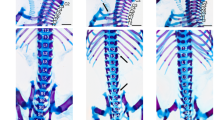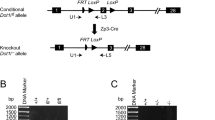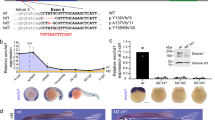Abstract
Prader–Willi syndrome (PWS), a human neuroendocrine disorder, is associated with deficiencies of paternal chromosome 15q12. Small nuclear ribonucleoprotein polypeptide N (SNRPN) is the first expressed gene identified in the PWS critically deleted region. Following our demonstration that the murine homologue of SNRPN is imprinted, we have characterized a sequence polymorphism within expressed portions of human SNRPN and show that human SNRPN is monoallelically expressed in fetal brain and heart and in adult brain. Analysis of maternal DNA and SNRPN cDNA confirmed that the maternal allele of SNRPN is not expressed in fetal brain and heart. Maternal imprinting of SNRPN supports the hypothesis that paternal absence of SNRPN is responsible for the PWS phenotype.
This is a preview of subscription content, access via your institution
Access options
Subscribe to this journal
Receive 12 print issues and online access
$209.00 per year
only $17.42 per issue
Buy this article
- Purchase on Springer Link
- Instant access to full article PDF
Prices may be subject to local taxes which are calculated during checkout
Similar content being viewed by others
References
Cassidy, S.B. Prader Willi syndrome. Curr. Prob. Pediatr. 14, 1–55 (1984).
Prader, A., Labhart, A. & Wilii, H. Ein syndrom von Adipositas, kleinwuchs, kryptochismus und ologophrenie nach myotonieartigem zustand in neugeborenalter. Schweiz. Med. Wochenschr. 86, 1260–1261 (1956).
Ledbetter, D.H. et al. Deletions of chromosome 15 as a cause of the Prader-Willi syndrome. New Engl. J. Med. 304, 325–329 (1981).
Nicholls, R.D. et al. Genetic imprinting suggested by maternal heterodisomy in non-deletion Prader-Willi syndrome. Nature 342, 281–285 (1989).
Knoll, J.H.M. et al. Angelman and Prader-Willi syndromes share a common chromosome 15 deletion, but differ in parental origin of the deletion. Am. J. meet. Genet. 32, 285–290 (1989).
Özçelik, T. et al. Small nuclear ribonucleoprotein polypeptide N (SNRPN), an expressed gene in the Prader-Willi syndrome critical region. Nature Genet. 2, 265–269 (1992).
Steitz, J.A., Black, D.L., Gerke, V. & Parker, K.A. Function of the abundant U-snRNPs. In Structure and Function of Major and Minor Small Nuclear Ribonuclear Ribonucleoprotein particles (ed. M.L. Bimstiel)115–154 (Springer-Verlag, New York, 1987).
Zieve, G.W. & Sauterer, R.A. Cell biology of the snRNP particles. Crit. Rev. Biochem. molec. Biol. 25, 1–46 (1990).
Hamm, J., Darzynkiewicz, E., Tahara, S.M. & Mattaj, I.W. The trimethylguanosine cap structure of U1 snRNA is a component of a bipartite nuclear targeting signal. Cell 62, 569–577 (1990).
Feeney, R.J., Sauterer, R.A., Feeney, J.L. & Zieve, G.W. Cytoplasmic assembly and nuclear accumulation of mature small nuclear ribonucleoprotein particles. J. biol. Chem. 264, 5576–5783 (1989).
Left, S.E. et al. Maternal imprinting of the mouse Snrpn gene and conserved linkage homology with the human Prader-Wiili syndrome region. Nature Genet. 2, 259–264 (1992).
Cattanach, B.M. et al. A candidate mouse model for Prader-Willi syndrome which shows an absence of Snrpn expression. Nature Genet. 2, 270–274 (1992).
Hayashi, K. PCR-SSCP: a simple and sensitive method for detection of mutations in the genomic DNA. PCR Meth. Appl. 1, 34–38 (1991).
Rokeach, L.A., Jannatipour, M., Haselby, J.A. & Hoch, S.A. Primary structure of a human small nuclear ribonucleoprotein polypeptide as deduced by cDNA analysis. J. biol. Chem. 264, 5024–5030 (1989).
Innis, M.A., Myambo, K.B., Gelfand, D.H. & Brow, M.A.D. DNA sequencing with Thermus aquaticus DNA polymerase and direct sequencing of polymerase chain reaction-amplified DNA. Proc. natn. Acad. Sci. U.S.A. 85, 9436–9440 (1988).
Bartolomei, M.S., Zemel, S. & Tilghman, S.M. Parental imprinting of the mouse H19 gene. Nature 351, 153–155 (1991).
Zhang, Y. & Tycko, B. Monoallelic expression of the human H19 gene. Nature Genet. 1, 40–44 (1992).
Zhang, Y. et al. Imprinting of human H19: allele specific CpG methylation, loss of the active allele in Wilms tumor, and potential for somatic allele switching. Am. J. hum. Genet. 53, 113–124 (1993).
DeChiara, T.M., Roberston, E.J. & Efstratiadis, A. Parental imprinting of the mouse insulin-like growth factor II gene. Cell 64, 849–859 (1991).
Ogawa, O. et al. Relaxation of insulin-like growth factor II gene imprinting in Wilms' tumor. Nature 362, 749–751 (1993).
Rainier, S. et al. Relaxation of imprinted genes in human cancer. Nature 362, 747–749 (1993).
Giannoukakis, N., Deal, C., Paquete, J., Goodyer, C.G. & Polychronakos, C. Parental genomic imprinting of the human IGF2 gene. Nature Genet. 4, 98–101 (1993).
Ohlsson, R. et al. IGF2 is parentally imprinted during human embryogenesis and in the Beckwith-Wiedemann syndrome. Nature Genet. 4, 94–97 (1993).
Barlow, D.P., Stöger, R., Herrmann, B.G., Saito, K. & Schweifer, N. The mouse insulin-like growth factor type two receptor is imprinted and closely linked to the Tme locus. Nature 349, 84–87 (1991).
Kalscheuer, V.M., Mariman, E.C., Schepens, M.T., Rehder, H. & Ropers, H.-H. The insulin-like growth factor type-2 receptor gene is imprinted in the mouse but not in humans. Nature Genet. 5, 74–78 (1993).
Forejt, J. & Gregorova, S. Genetic analysis of genomic imprinting: an lmprintor-1 gene controls inactivation of the paternal copy of the mouse Tme locus. Cell 70, 443–450 (1992).
Magenis, R.E. et al. Comparison of the 15q deletions in Prader-Willi and Angeiman syndromes: specific regions, extent of deletions, parental origin, and clinical consequences. Am. J. med. Genet. 35, 333–349 (1990).
Nakatsu, Y. et al. A cluster of three GABAA receptor subunit genes is deleted in a neurological mutant of the mouse p locus. Nature 346, 448–450 (1993).
Ogawa, O. et al. Constitutional relaxation of insulin-like growth factor II gene imprinting associated with Wilms' tumour and gigantism. Nature Genet. 5, 408–412 (1993).
Kitsberg, D. et al. Allele-specific replication timing of imprinted gene regions. Nature 364, 459–463 (1993).
Schmauss, C., McAllister, G., Ohosone, Y., Hardin, J.A. & Lerner, M.R. A comparison of snRNP-associated Sm-autoantigens: human N, rat N and human B/B'. Nucl. Acids Res. 17, 1733–1743 (1989).
Grimaldi, K. et al. Expression of the SmN splicing protein is developmentally regulated in the rodent brain but not in the rodent heart. Dev. Biol. 156, 319–323 (1993).
Author information
Authors and Affiliations
Rights and permissions
About this article
Cite this article
Reed, M., Leff, S. Maternal imprinting of human SNRPN, a gene deleted in Prader–Willi syndrome. Nat Genet 6, 163–167 (1994). https://doi.org/10.1038/ng0294-163
Received:
Accepted:
Issue Date:
DOI: https://doi.org/10.1038/ng0294-163
This article is cited by
-
Identification of functional lncRNAs in atrial fibrillation based on RNA sequencing
BMC Cardiovascular Disorders (2023)
-
Evidence for parent-of-origin effects in autism spectrum disorder: a narrative review
Journal of Applied Genetics (2023)
-
Sex-specific nicotine sensitization and imprinting of self-administration in rats inform GWAS findings on human addiction phenotypes
Neuropsychopharmacology (2021)
-
Maternal vitamin D depletion alters DNA methylation at imprinted loci in multiple generations
Clinical Epigenetics (2016)
-
The autism-related gene SNRPN regulates cortical and spine development via controlling nuclear receptor Nr4a1
Scientific Reports (2016)



